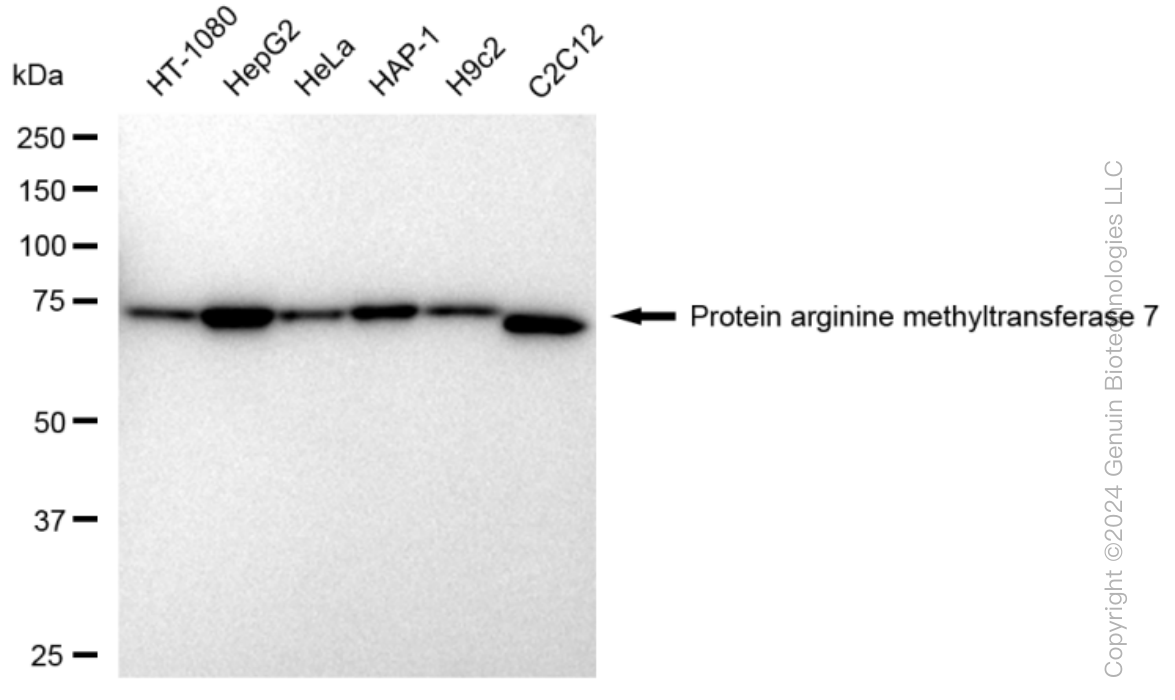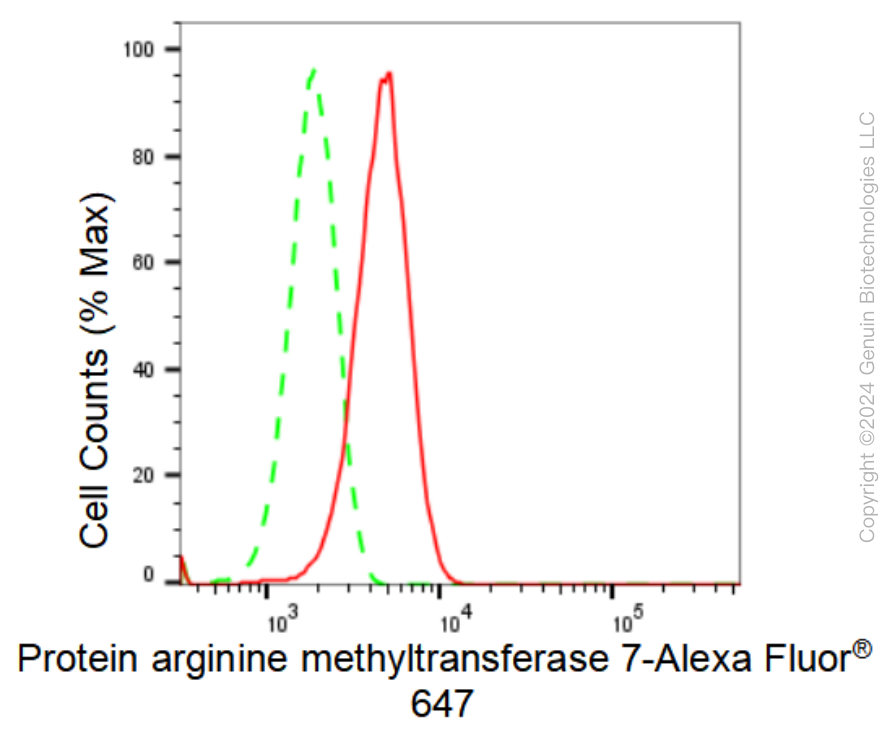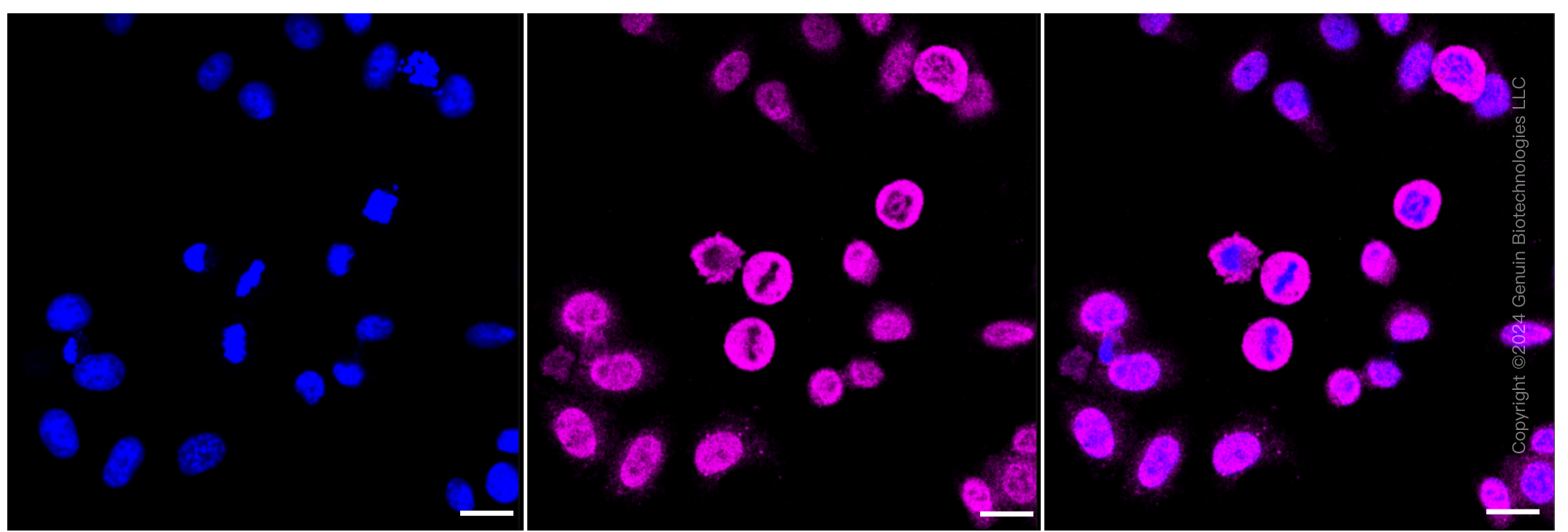KD-Validated Anti-Protein arginine methyltransferase 7 Rabbit Monoclonal Antibody
Rabbit monoclonal antibody
- SPECIFICATION
- CITATIONS
- PROTOCOLS
- BACKGROUND

Application
| WB, FC, ICC |
|---|---|
| Primary Accession | Q9NVM4 |
| Reactivity | Rat, Human, Mouse |
| Clonality | Monoclonal |
| Isotype | Rabbit IgG |
| Clone Names | 23GB 2380 |
| Calculated MW | Predicted, 78 kDa, observed, 75 kDa |
| Gene Name | PRMT7 |
| Aliases | PRMT7; Protein Arginine Methyltransferase 7; KIAA1933; [Myelin Basic Protein]-Arginine N-Methyltransferase PRMT7; Histone-Arginine N-Methyltransferase PRMT7; Protein Arginine N-Methyltransferase 7; FLJ10640; EC 2.1.1.321; EC 2.1.1 48; SBIDDS |
| Immunogen | A synthesized peptide derived from human PRMT7 |
| Gene ID | 54496 |
|---|---|
| Other Names | Protein arginine N-methyltransferase 7, 2.1.1.321, Histone-arginine N-methyltransferase PRMT7, [Myelin basic protein]-arginine N-methyltransferase PRMT7, PRMT7, KIAA1933 |
| Name | PRMT7 |
|---|---|
| Synonyms | KIAA1933 |
| Function | Arginine methyltransferase that can both catalyze the formation of omega-N monomethylarginine (MMA) and symmetrical dimethylarginine (sDMA), with a preference for the formation of MMA. Specifically mediates the symmetrical dimethylation of arginine residues in the small nuclear ribonucleoproteins Sm D1 (SNRPD1) and Sm D3 (SNRPD3); such methylation being required for the assembly and biogenesis of snRNP core particles. Specifically mediates the symmetric dimethylation of histone H4 'Arg-3' to form H4R3me2s. Plays a role in gene imprinting by being recruited by CTCFL at the H19 imprinted control region (ICR) and methylating histone H4 to form H4R3me2s, possibly leading to recruit DNA methyltransferases at these sites. May also play a role in embryonic stem cell (ESC) pluripotency. Also able to mediate the arginine methylation of histone H2A and myelin basic protein (MBP) in vitro; the relevance of such results is however unclear in vivo. |
| Cellular Location | Cytoplasm, cytosol. Nucleus |

Thousands of laboratories across the world have published research that depended on the performance of antibodies from Abcepta to advance their research. Check out links to articles that cite our products in major peer-reviewed journals, organized by research category.
info@abcepta.com, and receive a free "I Love Antibodies" mug.
Provided below are standard protocols that you may find useful for product applications.
If you have used an Abcepta product and would like to share how it has performed, please click on the "Submit Review" button and provide the requested information. Our staff will examine and post your review and contact you if needed.
If you have any additional inquiries please email technical services at tech@abcepta.com.














 Foundational characteristics of cancer include proliferation, angiogenesis, migration, evasion of apoptosis, and cellular immortality. Find key markers for these cellular processes and antibodies to detect them.
Foundational characteristics of cancer include proliferation, angiogenesis, migration, evasion of apoptosis, and cellular immortality. Find key markers for these cellular processes and antibodies to detect them. The SUMOplot™ Analysis Program predicts and scores sumoylation sites in your protein. SUMOylation is a post-translational modification involved in various cellular processes, such as nuclear-cytosolic transport, transcriptional regulation, apoptosis, protein stability, response to stress, and progression through the cell cycle.
The SUMOplot™ Analysis Program predicts and scores sumoylation sites in your protein. SUMOylation is a post-translational modification involved in various cellular processes, such as nuclear-cytosolic transport, transcriptional regulation, apoptosis, protein stability, response to stress, and progression through the cell cycle. The Autophagy Receptor Motif Plotter predicts and scores autophagy receptor binding sites in your protein. Identifying proteins connected to this pathway is critical to understanding the role of autophagy in physiological as well as pathological processes such as development, differentiation, neurodegenerative diseases, stress, infection, and cancer.
The Autophagy Receptor Motif Plotter predicts and scores autophagy receptor binding sites in your protein. Identifying proteins connected to this pathway is critical to understanding the role of autophagy in physiological as well as pathological processes such as development, differentiation, neurodegenerative diseases, stress, infection, and cancer.





